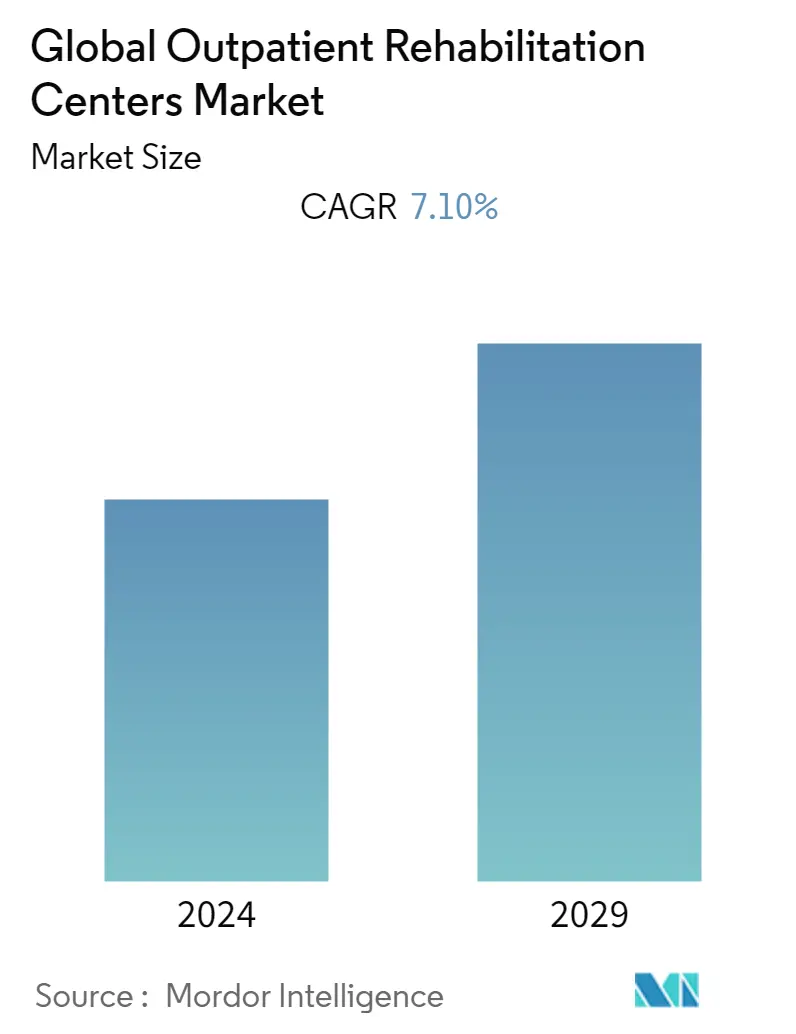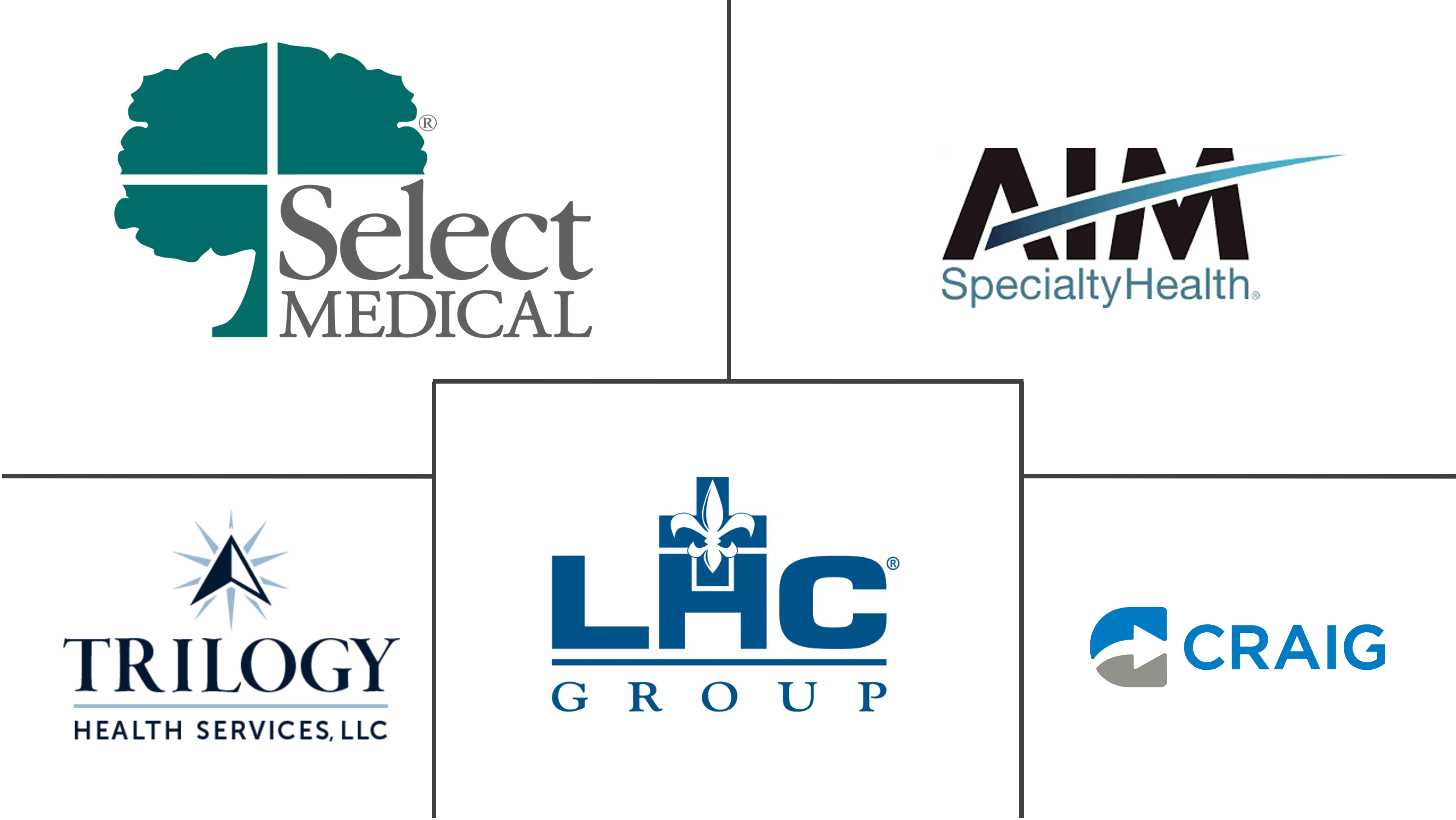Market Size of Global Outpatient Rehabilitation Centers Industry

| Study Period | 2019 - 2029 |
| Base Year For Estimation | 2023 |
| Forecast Data Period | 2024 - 2029 |
| CAGR | 7.10 % |
| Fastest Growing Market | Asia-Pacific |
| Largest Market | North America |
Major Players
*Disclaimer: Major Players sorted in no particular order |
Outpatient Rehabilitation Centers Market Analysis
The Outpatient Rehabilitation Centers Market is projected to register a CAGR of 7.1% during the forecast period.
During the COVID-19 pandemic, the outpatient rehabilitation centers market was adversely affected due to supply chain issues. Various research studies have provided insight into the impact of Covid on the studied market. For instance, in May 2020, a study published titled "COVID-19: Maintaining Essential Rehabilitation Services Across the Care Continuum" stated that enhanced measurement and monitoring are desperately needed at the individual, health system, and national levels. With the release of the world health organization (WHO) Rehabilitation Guide for Action, few countries had fully completed a systematic assessment of the rehabilitation situation and developed a strategic plan to adequately meet rehabilitative needs prior to this pandemic or to activate during pandemics. The following recommendations are provided to mitigate the consequences of COVID-19's impact on rehabilitation care and support continued health with a reduced risk of disability. Governments need to include rehabilitation and other direct care providers in home-based and community-based settings in their plans for personal protective equipment acquisition and training. Global collaboration among rehabilitation professionals needs to accelerate the sharing of resources, instructional tools, education, and training packets for how patients and families can continue rehabilitation at home during a pandemic response. Public health messaging on mental and physical health while social distancing needs to expand with input from rehabilitation professionals to provide guidance for persons living with physical and cognitive limitations, with and without caregivers. Public-private partnerships are needed to better support the rapid scale of telehealth today and in the future to ensure effective use, financing, cybersecurity, access, and increased reliability of broadband networks to reach people in low-resourced areas. Hence, with such initiatives, the market will grow in the upcoming future.
Factors such as increasing geriatric populations and increasing unhealthy lifestyles are primary reasons for the growth of the market. According to the World Health Organization report (WHO) report in 2020, by 2030, 1 out of every six people on the planet will be 60 years old or older. The number of people aged 60 and up is expected to rise from 1 billion in 2020 to 1.4 billion by 2050. By 2050, the global population of people aged 60 and above will get double to reach 2.1 billion. Between 2020 and 2050, the number of people aged 80 and above is expected to triple, reaching 426 million. According to the same source, while population aging - the shift in the distribution of a country's population towards older ages - began in high-income countries (for example, in Japan, 30% of the population is already over 60 years old), it is now low- and middle-income countries that are seeing the most change. Two-thirds of the world's population over the age of 60 will live in low- and middle-income countries by 2050. Since the older population is prone to diseases, this will increase the demand for outpatient care, thereby boosting market growth.
Increasing sedentary lifestyles and unhealthy food habits are key factors for the growth of the market as it increases the prevalence of diseases and thus require having outpatient care. According to the National Family Health Survey (NFHS-5) report 2019-2021, published in March 2022, there has been an increase in obesity in children under the age of five in 33 states and union territories. Experts have attributed the increase in obesity to a lack of physical activity and unhealthy eating habits. Additionally, a large majority of Indians tend to lead sedentary lives and lack the motivation to exercise. Hence, an increasingly sedentary lifestyle will increase the prevalence of diseases, which will boost the growth of the market in the upcoming future.
Thus, owing to the above-mentioned factors, the studied market growth is expected to increase during the study period.
Outpatient Rehabilitation Centers Industry Segmentation
As per the scope of the report, outpatient rehabilitation is an effective form of therapy for those with conditions that don't require intensive care. It has a lower cost and allows for a greater degree of freedom than inpatient therapy. Outpatient rehab is needed after many surgeries. As part of the recovery, the patient may start by getting care at a hospital. Depending on the nature or extent of the injury, the treatment might be given by physical therapists. The Outpatient Rehabilitation Centers Market is segmented by Program (Standard Outpatient Programs, Intensive Outpatient Programs, and Partial Hospitalization Programs), Therapy (Cognitive Behavioral Therapy, Contingency Management, Motivational Interviewing Treatment, The Matrix Model, and Family Therapy), End User (Pediatric Population, Adult Population, and Geriatric Population), and Geography (North America, Europe, Asia-Pacific, Middle East and Africa, and South America). The market report also covers the estimated market sizes and trends for 17 different countries across major regions globally. The report offers the value (in USD million) for the above segments.
| By Program | |
| Standard Outpatient Programs | |
| Intensive Outpatient Programs | |
| Partial Hospitilization Programs |
| By Therapy | |
| Cognitive Behavioral Therapy (CBT) | |
| Contingency Management (CM) | |
| Motivational Interviewing (MI) Treatment | |
| Others (Physical Therapy, Neurological Therapy, Occupational Therapy and Speech Therapy) |
| By End User | |
| Pediatric Population | |
| Adult Population | |
| Geriatric Population |
| Geography | ||||||||
| ||||||||
| ||||||||
| ||||||||
| ||||||||
|
Global Outpatient Rehabilitation Centers Market Size Summary
The Outpatient Rehabilitation Centers Market is poised for significant growth, driven by factors such as an increasing geriatric population and the prevalence of unhealthy lifestyles. The market, which experienced setbacks during the COVID-19 pandemic due to supply chain disruptions, is expected to recover and expand as governments and health organizations implement strategies to integrate rehabilitation services into community and home-based care. The aging population, particularly in low- and middle-income countries, is a major contributor to the demand for outpatient care, as older individuals are more susceptible to diseases requiring rehabilitation. Additionally, the rise in sedentary lifestyles and related health issues, such as obesity, is further propelling the need for outpatient rehabilitation services.
The North American market leads the global landscape, supported by a robust geriatric population and strategic expansions through new center launches and joint ventures. Key players like Select Medical Holdings and AIM Health Group Inc. are instrumental in shaping the competitive landscape, with recent expansions and acquisitions enhancing their service offerings. The pediatric segment also shows promise, with increasing chronic diseases among children driving demand for outpatient rehabilitation. As the market continues to evolve, the focus on telehealth and public-private partnerships is expected to play a crucial role in addressing the rehabilitation needs of diverse populations, ensuring sustained growth over the forecast period.
Global Outpatient Rehabilitation Centers Market Size - Table of Contents
-
1. MARKET DYNAMICS
-
1.1 Market Overview
-
1.2 Market Drivers
-
1.2.1 Increasing Geriatric Population
-
1.2.2 Rise in Unhealthy Lifestyle
-
-
1.3 Market Restraints
-
1.3.1 Dearth of Skilled Healthcare Professionals
-
-
1.4 Porter Five Forces
-
1.4.1 Threat of New Entrants
-
1.4.2 Bargaining Power of Buyers/Consumers
-
1.4.3 Bargaining Power of Suppliers
-
1.4.4 Threat of Substitute Products
-
1.4.5 Intensity of Competitive Rivalry
-
-
-
2. MARKET SEGMENTATION (Market Size by Value - USD million)
-
2.1 By Program
-
2.1.1 Standard Outpatient Programs
-
2.1.2 Intensive Outpatient Programs
-
2.1.3 Partial Hospitilization Programs
-
-
2.2 By Therapy
-
2.2.1 Cognitive Behavioral Therapy (CBT)
-
2.2.2 Contingency Management (CM)
-
2.2.3 Motivational Interviewing (MI) Treatment
-
2.2.4 Others (Physical Therapy, Neurological Therapy, Occupational Therapy and Speech Therapy)
-
-
2.3 By End User
-
2.3.1 Pediatric Population
-
2.3.2 Adult Population
-
2.3.3 Geriatric Population
-
-
2.4 Geography
-
2.4.1 North America
-
2.4.1.1 United States
-
2.4.1.2 Canada
-
2.4.1.3 Mexico
-
-
2.4.2 Europe
-
2.4.2.1 Germany
-
2.4.2.2 United Kingdom
-
2.4.2.3 France
-
2.4.2.4 Italy
-
2.4.2.5 Spain
-
2.4.2.6 Rest of Europe
-
-
2.4.3 Asia-Pacific
-
2.4.3.1 China
-
2.4.3.2 Japan
-
2.4.3.3 India
-
2.4.3.4 Australia
-
2.4.3.5 South Korea
-
2.4.3.6 Rest of Asia-Pacific
-
-
2.4.4 Middle-East and Africa
-
2.4.4.1 GCC
-
2.4.4.2 South Africa
-
2.4.4.3 Rest of Middle-East and Africa
-
-
2.4.5 South America
-
2.4.5.1 Brazil
-
2.4.5.2 Argentina
-
2.4.5.3 Rest of South America
-
-
-
Global Outpatient Rehabilitation Centers Market Size FAQs
What is the current Global Outpatient Rehabilitation Centers Market size?
The Global Outpatient Rehabilitation Centers Market is projected to register a CAGR of 7.10% during the forecast period (2024-2029)
Who are the key players in Global Outpatient Rehabilitation Centers Market?
Select Medical Holdings, AIM Health Group Inc., LHC Group, Inc., Trilogy Health Services, LLC. and Craig Hospital are the major companies operating in the Global Outpatient Rehabilitation Centers Market.

